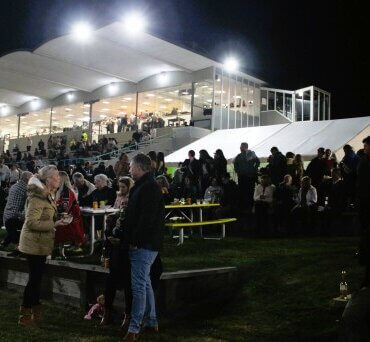

Cambridge Raceway chair Graham Bowen and chief executive Dave Branch (right). Photo: Mary Anne Gill.
A glass bottle crusher could solve two major problems for Cambridge Raceway – fixing potholes and recycling the thousands of bottles generated at the sports venue every year.
And though an application to Waipā District Council’s Waste Minimisation Community Fund for help to buy the $7000 machine was unsuccessful, Raceway chief executive Dave Branch is determined to make it happen.
Branch and his team have already introduced several initiatives which keep rubbish out of landfills.
They grow their own produce on site to supply the onsite sports bar and catering company. Food waste is fed to their own worms to generate plant fertiliser made up of the worms’ wee – their own chickens produce eggs and composted manure feeds the gardens.
The Raceway has 30 race meetings a year and because they do not have beer on tap, they have thousands of empty glass bottles to get rid of.
Recycling involves sorting the bottles into colours which is time consuming and the track has only 10 staff, all involved in race activities.
A glass crusher machine would turn the glass bottles into sand which when mixed with an emulsion, can be used to fill potholes.
It is common in Australia for training track surfaces to be made from glass, said Branch.
“Success will be measured by the reduction in waste that goes to land fill,” he said.
“We estimate we could instantly reduce our skip bins from two to one essentially cutting our waste to land fill in half.”
The bins are emptied once a week but twice after a big race meeting and glass bottles makes up most of it.

A stretch limousine arrives at Cambridge Raceway for the Harness Jewels meeting three years ago. Photo: Mary Anne Gill.
Meanwhile the Raceway club is continuing with its financial recovery after reporting an operating deficit of $730,000 last year.
The club secured a loan from Harness Racing New Zealand and members to bolster the bottom line.
The sale of a 34-lot residential subdivision where the club’s stables currently are will generate revenue as will the upcoming Grins Night on April 12.
The club’s upgraded kitchen now gives its in-house caterers the opportunity to cater for other events at Mystery Creek, Lake Karāpiro and the Velodrome.










